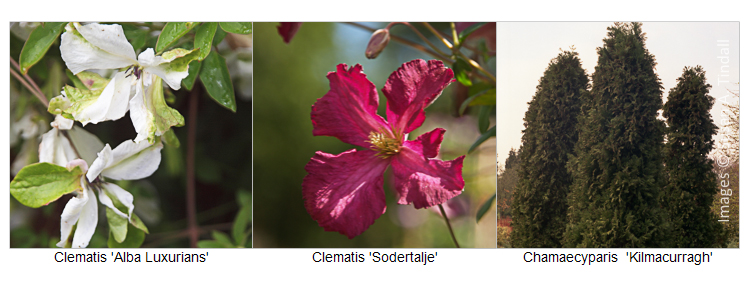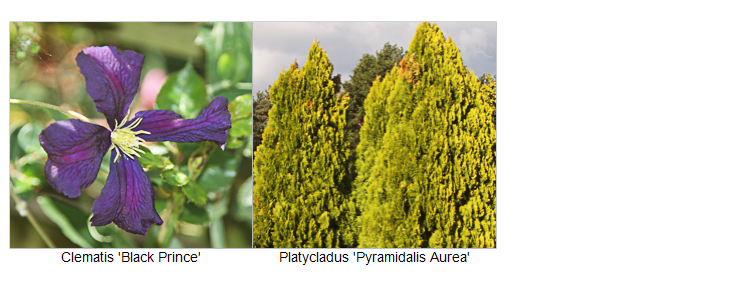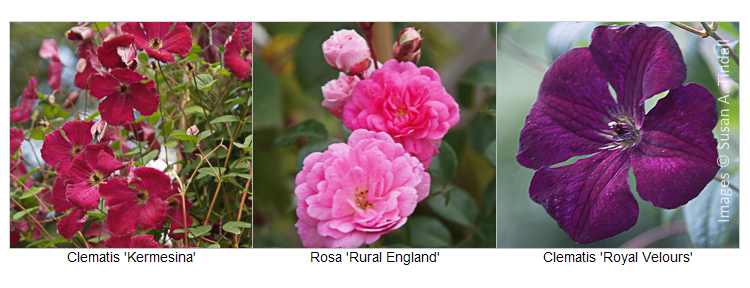The summer-flowering clematis that belong to the viticella group are the easiest, possibly even the most-satisfying of them all. If you have never grown clematis before, or have had some disappointments with them, the Viticellas are the perfect solution.
They flower from late June or July, sometimes going into autumn. They are vigorous climbing plants that are remarkably easy to grow and care for. Most of them reach 4 metres or more and provide masses of flowers that spread over a good area, thus providing a substantial visual return for your investment. The flowers are generally single and quite simple in appearance, often with a nodding habit, and sometimes having contrasting stamens at their heart. These forms provide invaluable cover for vertical surfaces, particularly fences and walls that can be a loud presence in small gardens. The clematis will soften boundaries and provide a backdrop to other plants.
Growing ‘Just the one’
It can be helpful to try growing a single specimen for a while. This will give you experience of the general character of these plants and their fit to your style of gardening. For starters try the soft but deep red blooms of Clematis ‘Kermesina’. This has quite large flowers for the group and provides a rich show from late June through most of August. Red shades look particularly attractive against green foliage shrubs.
Clematis with roses
Classically clematis are combined with roses, often to beautiful effect. Viticella forms are unsuited to roses that are described as ‘summer flowering’ since these flower in June and finish about the time the clematis get going. Therefore choose climbing roses that flower through the summer. Good combinations are pink and purple shades. An example being the rambling rose Rosa ‘Rural England’with its’ clusters of small warm pink flowers combined with the velvet purple of the rounded blooms of Clematis ‘Royal Velours’.
For a fresh white and pink combination try the sophisticated Rosa Swan Lake = ‘Macmed’ with the unusual four-petalled Clematis ‘Minuet’ strikingly coloured white and dusky pink. Finally, the nodding fan-shaped blooms of light blue-mauve Clematis ‘Betty Corning’ with the unusually coloured Rosa ‘Crepuscule’ that has clusters of copper-hued yellow flowers that are fully double.

Clematis trained over plants
The viticella clematis is beautiful when trained over substantial shrubs. The dark green of yews or columnar Lawson cyprus such as Chamaecyparis lawsoniana ‘Kilmacurragh’ can be combined with the white, green tipped flowers of Clematis ‘Alba Luxurians’ or the rich red of Clematis ‘Sodertalje’. Finally, for something really bright, combine the velvety black-red nodding flowers of Clematis ‘Black Prince’ on the golden foliage of conifers such as textured Platycladus orientalis ‘Pyramidalis Aurea’.


Care details
Viticella clematis is hard-pruned in late winter or early spring when the plants are cut back to the first pair of buds above ground level. The old foliage can then be pulled away from its supports. Vigorous young shoots will shortly appear. As with all plants, clematis need plenty of water and should be fed regularly or use a slow-release fertiliser in spring.
Enjoy your clematis.
Susan A. Tindall
Further details of these and other clematis are available in the Gardenforpleasure.co.uk Plant Finder.

